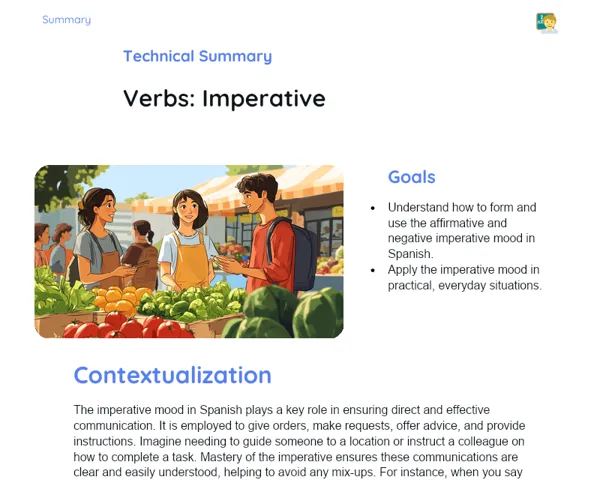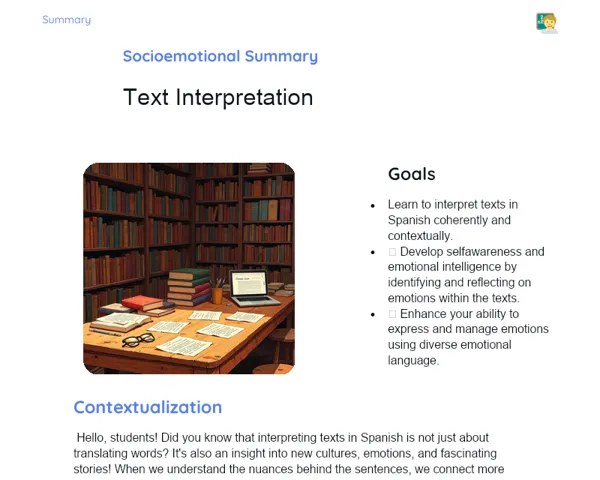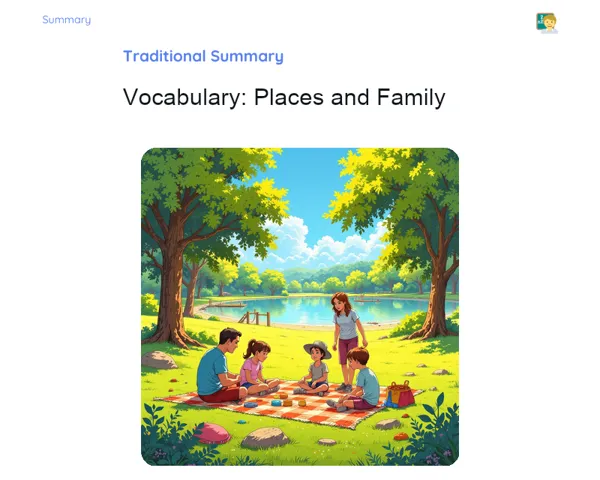Socioemotional Summary Conclusion
Goals
1. To recognize and accurately write verbs in the pluperfect subjunctive tense in Spanish.
2. To distinguish the pluperfect subjunctive from other verb tenses.
3. To apply this verb tense in suitable contexts, both in writing and speaking.
4. To develop a deeper awareness of the emotions and hypothetical situations associated with the pluperfect subjunctive.
Contextualization
🤔 Have you ever thought about how things could have been different in your life? The pluperfect subjunctive in Spanish lets us explore these 'what if' scenarios! With this, we can weave alternative narratives and gain better insights into our emotions during various situations. Ready to journey through time? 🚀
Exercising Your Knowledge
Structure of the Pluperfect Subjunctive
The pluperfect subjunctive is formed by using the auxiliary verb 'haber' in the imperfect subjunctive (hubiera, hubieras, hubiera, hubiéramos, hubierais, hubieran) alongside the past participle of the main verb. This structure is essential for crafting sentences that express conditions or events that were possible in the past but didn’t occur. Mastering this structure allows you to convey complex emotional and contextual nuances in your conversations.
-
Auxiliary verb 'haber': It’s crucial to master the conjugation of 'haber' in the imperfect subjunctive as it lays the foundation for the pluperfect subjunctive.
-
Past participle: Knowing how to form the past participle of main verbs is vital, as it completes the tense’s structure.
-
Hypothetical contexts: This tense is often used for thinking about assumptions and imaginary situations, which enhances your ability to express both emotional and intellectual sentiments in Spanish.
Usage in Appropriate Contexts
The pluperfect subjunctive is commonly used to express hypothetical past actions, particularly in conditional sentences. This usage enables you to delve into scenarios that didn’t occur but might have had significant emotional repercussions. Learning to apply it correctly is vital to enhancing your communication skills and empathetic understanding.
-
Conditional sentences: Grasp how to employ the pluperfect subjunctive in sentences that articulate unrealized conditions, such as 'If I had known, I would have done things differently.'
-
Emotional impact: Recognize how this verb tense can express feelings of regret, remorse, or longings for change.
-
Flexibility in communication: The ability to use this verb tense boosts your capacity to discuss past experiences in nuanced and emotionally rich contexts.
Socioemotional Connection
The application of the pluperfect subjunctive transcends mere grammatical rules; it fosters a profound connection with our emotions and reflections on past events. Using this verb tense not only enhances your Spanish but also encourages greater emotional intelligence, empathy, and self-reflective skills.
-
Empathy: Crafting hypothetical scenarios allows you to empathize with others, giving you insight into their emotions and reactions.
-
Self-awareness: Pondering how past events could have been different aids in comprehending your own emotions and choices.
-
Emotional regulation: Learning to articulate complex feelings through the pluperfect subjunctive can serve as a powerful tool for addressing regrets and learning from the past.
Key Terms
-
Pluperfect Subjunctive: A verb tense used to convey actions that could have taken place in the past under specific conditions.
-
Auxiliary verb 'haber': The verb employed in forming the pluperfect subjunctive.
-
Past participle: The verb form that, together with 'haber,' makes up the pluperfect subjunctive.
-
Hypothetical scenarios: Imagined situations or events that did not occur but were possible.
For Reflection
-
How can studying the pluperfect subjunctive improve your understanding of your own emotions and those of others?
-
Remember a time when you wished something had gone differently. How do you feel reflecting on that using the pluperfect subjunctive?
-
In which ways can the skill to imagine hypothetical scenarios impact your decision-making and social interactions?
Important Conclusions
-
The pluperfect subjunctive is a crucial verb tense for articulating hypothetical actions that might have happened in the past.
-
The combination of the auxiliary verb 'haber' in the imperfect subjunctive with the past participle is foundational for this tense.
-
This verb tense enhances our ability to create hypothetical scenarios and understand complex emotions tied to different situations.
-
Mastering the pluperfect subjunctive enriches our vocabulary and communication prowess in Spanish, giving us fresh ways to express empathy and emotional insight.
Impacts on Society
Grasping and utilizing the pluperfect subjunctive greatly enhances our ability to express ourselves in a richer and more empathetic manner in Spanish, especially in social and cultural contexts where language acts as a bridge to mutual understanding. By imagining and discussing hypothetical scenarios, we can explore various perspectives and emotions, which potentially improves our interactions and deepens our relationships.
On an emotional front, the act of reflecting on how things could have unfolded differently helps us manage regrets and make more intentional choices going forward. Moreover, this reflective capability can be invaluable in professional, academic, and personal contexts, where the skill to analyze multiple possibilities and their emotional implications can lead to more effective and empathetic resolutions to complex issues.
Dealing with Emotions
To practice the RULER method, start by identifying and naming the emotions you experience when considering a hypothetical scenario from the past. Understand the sources of these emotions and how they affect your present. Next, attempt to articulate these feelings through a brief text or conversation using the pluperfect subjunctive. Finally, reflect on how to effectively regulate these emotions, perhaps by discussing them with a peer or jotting them down in a journal.
Study Tips
-
Practice conjugating the auxiliary verb 'haber' in the imperfect subjunctive and forming the past participle of main verbs. Utilize flashcards and apps for reinforcement.
-
Write dialogues or short texts imagining different hypothetical scenarios from your life. This will help solidify your understanding of the pluperfect subjunctive.
-
Review examples of conditional sentences using the pluperfect subjunctive and create your own. Share them with friends or colleagues for feedback to enhance your understanding.



